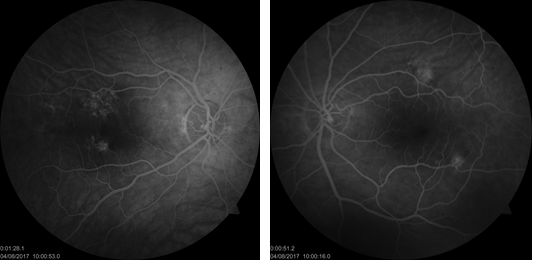Case Report
Volume 1 Issue 5 - 2018
Central Serous Chorıoretınopathy After Vestıbular Schwannoma Treatment: A Case Report
1Department of Ophthalmology, Okmeydani Training and Research Hospital, Istanbul, Turkey
2Department of Ophthalmology, Sisli Hamidiye Etfal Training and Research Hospital, Istanbul, Turkey
2Department of Ophthalmology, Sisli Hamidiye Etfal Training and Research Hospital, Istanbul, Turkey
*Corresponding Author: Gamze Maden, Department of Ophthalmology, Okmeydani Training and Research Hospital, Istanbul, Turkey.
Received: December 28, 2017; Published: January 20, 2018
Abstract
Central serous chorioretinopathy (CSR) is a disease that typically occurs in young males which is characterized with central serous detachments that regress spontaneously. Most of the cases recover spontaneously in a few weeks, however in some cases it can become chronicle, permanent or last as long as six months or longer. The 54-year-old-patient with Vestibular Schwannoma (VS) who had consulted to Istanbul Okmeydani Research and Training Hospital Ophthalmology Clinicwith the complaint of decreased vision in the right eye has been diagnosed with chronicle CSR. Since it is well-known that corticosteroid usage is an important risk factor for CSR, it has been considered interesting for etiological assignation that the case had received Cyber Knife treatment due to VS during the same period. It should be taken into consideration that secondary CSR can develop with steroid treatment which is used with CyberKnife treatment that is practiced currently and increasingly for the treatment of many tumor types.
Keywords: Schwannoma; CyberKnife; Central Serous Chorioretinopathy; Corticosteroid
Case Presentatıon
The 54-year-old-female patient G.Ş. consulted to Istanbul Okmeydani Research and Training Hospital Ophthalmology Clinicwith the complaint of decreased vision in the right eye. Based on the case’s history, it was revealed that 2, 5 years ago the patient had received CyberKnife treatment due to VS and visual complains started after that. During the ophthalmologic examination the observations turned out to be as following: right vision 1 mps uncorrected, no increase with correction, left vision 1.0, right-left eye anterior segment normal, right eye’s fundus observation retinal pigment epithelium (RPE) change in the macula, left eye’s fundus observation normal. Optic Coherence Tomography (OCT) and Fundus Fluorescein Angiography (FFA) were recommended for the case. With the OCT’s taken, RPE change in the right eye, window defection in the back poles of the right and the left eye were observed and no active leakage was noticed in the late phases. Right and left peripheral retinas were observed as natural. FFA images proved to be coherent with chroniclecentral serous retinopathy. As the anamnesis of the case’s was dwelt into further, it was discovered that the patient had used 32 mg of oral methylprednisolone daily and it was cut down digressively until completely given up. Chronicle CSR was linked to the aforementioned situation. Since the disease wasn’t in an active phase no treatment was offered and a follow-up was recommended.
Dıscussıon
Vestibular Schwannomas are benign tumors, however they can cause mass growth and serious secondary morbidity [1]. CyberKnife® (Accuray Inc., Sunnyvale, CA) which was developed recently has a significant place with a variety of tumors’s treatment [2]. CyberKnifeunit is a robotic radiosurgery system which delivers radiation to the target with a real time image guidance system. This treatment has been fractioned to decrease the damage to the neighbouring critical structures [3]. This treatment is also used for intraocular melanomas. And when it is used for this purpose neovascular glaucoma, cataract, vitreous hemorrhage, optic neuropathy are the main complications which occur [4-5]. Yet no ophthalmic complications have been reportedrelating to its usage for VS.
The CSR’s with our patient is thought to have developed as secondary to the long term systemic corticosteroid usage. Because even though maculopathy is one of CyberKnife’s treatment’s well-known side effects, aforementioned side-effect is known to appear with ocular tumor treatment. There is no maculopathy case with intracranial tumor treatment which has been reported. The long term systemic corticosteroid usage in the etiology supports our claim as well. However the lack of evidence regarding the development of maculopathy after intracranial CyberKnife treatment and the concurrent appliance of systemic corticosteroid treatment may prevent us from clarifying the etiology. Treatment results to be evaluated from a broader range of cases can help us confirm the etiology.
References
- Pannullo SC., et al.“Stereotacticradiosurgery: a meta-analysis of currenttherapeuticapplications in neuro-oncologicdisease”. Journal of Neuro-Oncology 103.1 (2011): 1-17.
- Satar B and Arslan HH. “New Approaches for Treatment of Vestibular Schwannoma”. Turkiye Klinikleri Journal of Ear Nose and Throat-Special Topics 6.3 (2013): 85-100.
- Mueller AJ., et al. “Stereotacticradiosurgery of largeuvealmelanomaswith Gamma Knife”. Ophthalmology 107.7 (2000): 1381-1387.
- Modorati G., et al. “Gamma Kniferadiosurgeryforuvealmelanoma: 12 years of experience”. British Journal of Ophthalmology93.1 (2009): 40-44.
- Modorati G., et al. “Gamma Knife radiosurgery for uveal melanoma: 12 years of experience”. British Journal of Ophthalmology93.1 (2009): 40-44.
Citation:
Gamze Maden., et al. “Central Serous Chorıoretınopathy After Vestıbular Schwannoma Treatment: A Case Report”. Ophthalmology
and Vision Science 1.5 (2018): 183-185.
Copyright: © 2018 Gamze Maden., et al. This is an open-access article distributed under the terms of the Creative Commons Attribution License, which permits unrestricted use, distribution, and reproduction in any medium, provided the original author and source are credited.




































 Scientia Ricerca is licensed and content of this site is available under a Creative Commons Attribution 4.0 International License.
Scientia Ricerca is licensed and content of this site is available under a Creative Commons Attribution 4.0 International License.